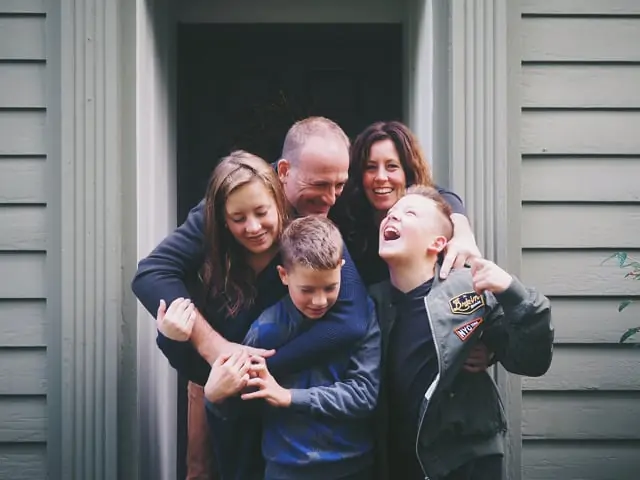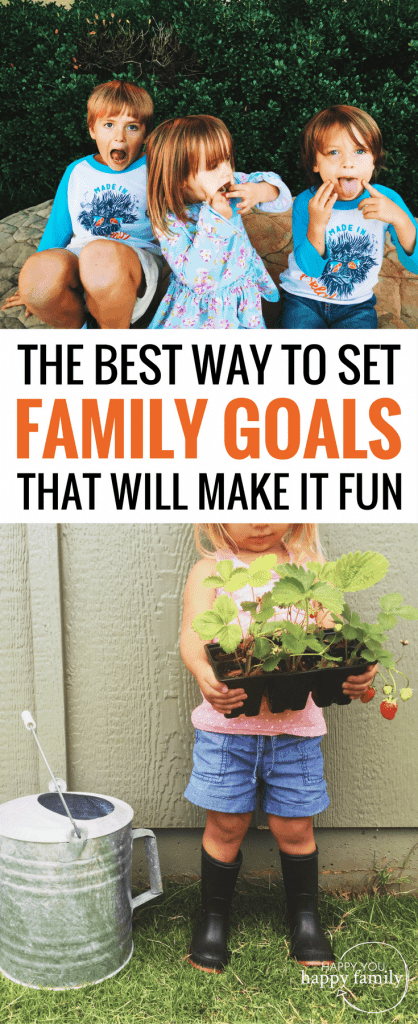Want Your Family to Share the Load? Here’s the Best Way to Set Family Goals
One night a while back, my husband and I collapsed on the couch after wrangling our three kids to bed. We passed a pint of Ben & Jerry’s back and forth between us, decompressing about the day. We talked about…
- How we still needed to pay the bills that have been sitting on the counter for a week,
- Whether our toddler turning three next year will help her tantrums or make them worse, and
- How two out of three kids willingly and happily eating Brussels sprouts isn’t all bad – but getting our preschooler on board for three out of three would be epic.
“When we start our garden, the kids will be so excited to eat what they helped grow,” Ty said. “Just watch. I bet she’ll be way more into veggies after that.”
Oh, I thought. The garden. The corners of my mouth slipped down.
We’ve been talking about starting a backyard veggie garden for years. It started when we got an all-in-one garden kit for Christmas one year, and the kids had an absolute blast watering it and checking on it everyday.
On the day they saw sprouts peek out from the soil, you’d have thought we just told them we were moving to live inside the Cinderella Castle at Disney World. But then the cats dug up every last plant, and we had to pitch the whole thing.
I want to start a new garden, Ty wants to start a garden, and the kids can’t wait to start a garden.
And yet, every time the dang garden comes up in conversation, it stresses me out.
Bonus: As a bonus for joining my weekly newsletter, get a free worksheet that will help you get your kids excited about setting family goals – and working towards them as a team.
Here’s the Problem With Setting Family Goals
Dreaming about your future is supposed to be fun.
But when you’re so overwhelmed by your neverending mental to-do list that you can’t even get around to paying three measly bills that have been sitting on the kitchen counter for a week? Dreaming about the future is just One More Thing to add on top of your overflowing to-do list.
Earlier this year, Ty started making plans for our garden – reading a gardening book cover to cover, sketching out where our garden would go in the backyard, figuring out which supplies we’d need.
But every time the garden came up in conversation, I bristled.
I didn’t want to talk about it because I had a million must-dos to worry about before I could think about a nice-to-have bonus.
One kid is overdue for a well-check, we need to check Craigslist for a bassinet before our newest little one is born, the kitchen cabinet where we keep all the art and craft supplies is on the verge of turning into an avalanche every time we open it, and on and on. How can I take time away from all that to plan a garden?

Then He Did Something Brilliant
One night after dinner, we all sat around the table, taking turns asking questions from our favorite set of family conversation starters.
The question was “What makes you feel loved?” and our oldest answered, “When you play with my hair.” Our preschooler said, “When you read That’s Me Loving You.”
Then our toddler said, “When you give me dessert!”
We all laughed, and Ty stood up. “Well, I have good news then. How about s’mores?”
Squeals of delight from the kids. He grabbed our official s’mores supplies container out of the pantry.
“But first,” he announced. “I have something I want to talk about.” With a bag of marshmallows in hand, he had the kids’ attention.
“We’ve been talking about starting a new family garden for a while, and I want to decide as a family when we’ll start it.”
He set the marshmallows down and walked over to our family dry-erase board in the dining room, a neon pink marker in hand.
“We already missed the fall planting season, but the next good time to start would be in January,” he said. He wrote “Garden: January?” on the board.
“When’s January?” my 4-year-old asked.
My oldest turned to her. “That’s right after Christmas.”
“Let’s start in January!” my 4-year-old yelled.
Ty and I laughed. “What do you think?” I asked my oldest.
She smiled. “Yeah, let’s do that.”
I glanced at the toddler, who was still eyeing the marshmallows on the counter. “Do you want to start a garden after Christmas?” I asked her.
“Can we have s’mores now?” Fair enough.
Ty laughed, then used the heel of his hand to erase the question mark after January. “January it is, then,” he said.
And I realized: At no point during that conversation about the garden did I bristle against the idea. I didn’t feel stressed at all. And the whole exchange even left me a little bit…excited.
What sorcery is this?! I wondered.
Related: 150 Conversation Starters for Kids That Will Unlock Your Child’s Heart

So…What Made the Difference?
When I’m overwhelmed by the daily work of parenting, I feel lucky to keep up with the bare minimum on my to-do list. Every day feels like a battle to keep the sink from filling up with a week’s worth of dirty dishes, stop one kid’s bad mood from dragging down the whole family, make sure the kids don’t run out of clean laundry and have to resort to wearing their underwear inside out, and more.
I loved the idea of family goal-setting for growing and working together as a family, but the problem was we hadn’t moved from the idea stage to actually setting family goals.
Then my husband took our “one day” idea of starting a family garden, and he called an impromptu family goal-setting session.
But because he nudged us to pick a date and then wrote it down to make it official, that “one day” idea shifted into a family goal that we’d all bought into and had a say in.
The stress of figuring out how to fit in One More Thing on the teetering tower of to-dos in my head disappeared because we had a date and a plan.
And it makes sense. Because as I found out later, research shows that one of the best ways to fight stress is to come up with a plan for whatever you’re stressed about – instead of just letting things happen.
Related: 7 Best Family Bonding Games That Will Help You Reconnect Quickly {Printable}

How Family Goal-Setting Will Make Your Job As a Parent Easier
I mistakenly thought family goal-setting would just give me more to-dos, but I was missing the big picture.
Setting family goals transcends the daily slog of family life that can make us feel run-down and overwhelmed. Because when you’re working together towards a common goal, your connection with your family will be stronger.
Why does that matter? Connection breeds cooperation.
For example, when your kids feel a strong connection with you:
- Your kids will feel safer talking to you about tough topics, like problems with friends or something they’re struggling with at school.
- They’ll be more willing to jump in and help out, like when you’re making dinner or folding laundry.
- They may even listen the first time you ask them to pick up their toys – or at least they’ll listen before you get to your breaking point and threaten to throw all their toys in the trash.
Plus, setting family goals is an excellent way to teach your kids an important life skill before they leave the house: how to set a goal and stick to it until it’s done.

How to Set Family Goals Without Making It Formal And Weird
Until my husband’s impromptu family goal-setting session, I thought the idea of setting family goals sounded a little…stuffy.
But after that experience, I read as much as I could about the best way to set family goals, and I learned that setting family goals definitely doesn’t have to be formal or weird. It can actually be fun.
Since that day, we’ve set a few more goals together – big and small. I talked to every parent I know about how they tackle family goal-setting, and we worked out the kinks on the best process for how to set family goals.
Every family is different, but here are the “gotchas” we ran into and how to avoid them, plus the steps that brought about the best reactions from the whole family. And remember: The promise of s’mores certainly doesn’t hurt.
1. Pick One
Before you start a conversation with the whole family, pick just one family goal you’d like to talk about. The idea of setting family goals can be exciting because you’re dreaming of and planning for the future, so you may be tempted to bring up a few goals all at once. But especially if it’s your first attempt at family goal-setting, tackling more than one goal can be overwhelming – for you and the kids.
When you have a spouse or partner, you can try picking your first family goal after the kids are in bed.
Family Goals Examples
If you need ideas, here are a few family goals examples I’ve heard from friends and extended family:
- Divvy up household chores to share the workload
- Save up for a special family vacation
- Eat more veggies
- Volunteer together
- Spend more time together as a family, like a family date night out, game night, movie night, and so on
- Be more physically active together
- Commit to having a device-free dinner every night
- Start a family book club
- Go somewhere new once a month
- Start a garden
- Take a class together, like a cooking class or a self-defense class
- Establish a day once a month that mom gets the day off and everyone has to take care of her for a change (A girl can dream!)
2. Preload the First Decision
Make a decision ahead of time about when you’ll start the family goal-setting conversation with everyone. This will keep the idea from becoming another “one day” task that’s floating around in your head, competing for attention with all the other things on your mental to-do list.
You may get the best results if you start the conversation during or after a fun family event or tradition, like on pizza night, on family game night, before dessert, after a happy-making dance party, and so on.
For example, you might say, “After pizza night on Friday, I’ll start the conversation about saving up for a trip to Hawaii.”
To help you remember, you can set a reminder in your phone or tablet, or mark it on whatever calendar you use.
Also, no need to wait until January for these conversations! You can set family goals any time of year.
Related: Forget Candyland! This Is the Best List of Board Games for All Ages
3. Gather a Few Fun Supplies (Optional)
After you pick a date, you may want to gather a few helpful supplies before the conversation.
During the talk, it will be important to write down every idea offered up. (More on why that is in a minute.) So here are a few supplies you might find useful for doing that:
- Pick up a few brightly colored Post-It Notes† so you can write ideas down and stick them on the wall while everyone talks,
- Get a jumbo-sized Post-It pad that you can put on the wall and write everything on, or
- If you have a chalk board or white board in your home, consider having the family goal-setting session near that. We have this cool black dry-erase board hanging in our breakfast nook – it’s where we write down our weekly meal plan, errands we need to run, important dates, and more – so that’s where we do our family goal-setting. (And here are the best markers we’ve found after trying lots of duds that dried out fast.)
4. Pretend You’re the WD-40
After talking to many other parents about how they tackle family goal-setting, I’ve learned the number one danger is allowing yourself as the parent to assume the role of dictator, not facilitator. The truth is when you’re standing up in front of everyone trying to lead a discussion, it’s natural to find yourself responding to blank stares and silence by sharing your opinions and ideas.
Unfortunately, as a leader in your family, sharing your opinions and ideas first may cause everyone else to clam up. Your kids especially may be scared to share their thoughts because they’re expecting to be told “no.” And to be fair, kids do tend to hear “no” from parents a lot, so it’s understandable that they’d feel hesitant to speak up.
But if you do all the talking, your family goal-setting session can quickly become a one-woman or one-man show. The problem with that? Without involvement and buy-in from the rest of your family, it will be hard to make real progress on whatever goal you had in mind. And goodness knows you don’t need any more family goals resting solely on your own shoulders.
Here are a few tried-and-true tricks for making sure that setting family goals ends up being a group effort, not a top-down dictatorship. Just remember: Above all, your goal is to grease the wheels of the conversation – be the WD-40.
- Invite everyone to chime in. You can do this by quickly stating what you want to talk about, then shifting right into a question. For example, you might say something like, “We’ve been talking about starting a family book club for a while, so can we come up with a plan for starting it?” Or as another example: “Dad and I thought it would be fun to start volunteering together as a family to help others who haven’t been as lucky as we have. What do you think?” Or: “You might have noticed that Mom and I act like the Oscar the Grouch when we’re doing household chores all alone. How can we all pitch in to get housework done faster?”
- Repeat and write. This is where those colorful Post-It Notes, giant Post-It pads, or a white board or chalkboard from step 3 can come in handy. For every idea or question someone offers up, repeat it out loud then write it down without making any comment on the idea. Even if you don’t end up using that idea, this simple step will help everyone feel heard and like they contributed to the conversation. If you skip this step, you can quickly kill the brainstorming vibe. If you shoot down an idea right after your kid offers it up, she’ll be less likely to speak up again, and you’ll be left with blank stares instead of an engaged family. After you write down all the ideas, you can circle back and decide as a group which ones to incorporate.
- Summarize often. One helpful trick that several parents mentioned is to summarize the conversation as much as possible. This could be your kids’ first experience having a group discussion with the goal of making a joint decision, so summarizing the major points can help them keep track of the direction of the conversation. One phrase that works well for this is, “What I’m hearing is that xyz. Does that sound right?” For example, you might say something like, “What I’m hearing is that we all want to go to Hawaii this year, but saving up that much money that quickly would mean making some sacrifices.” or “What I’m hearing is that we’d all love a family game night, but if Mom has to play Candyland one more time she may gouge her eyes out with a junky plastic game piece.”
5. WOOP Your Goal
Now you know how to facilitate the family goal-setting conversation, but how do you come up with a plan that will make your goal a reality?
You need WOOP.
The WOOP method for tackling personal goals is based on more than 20 years of research on what motivates us and what will drastically increase our chances of success in meeting those goals.
Here’s what the acronym stands for, plus how each step helps you make your goal a reality. At the end of this post, you’ll also get a handy printable that will help you use WOOP while setting family goals.
- Wish – What do you dream of achieving? Ask everyone to say what they want out loud. Just be careful not to get stuck in this step, fantasizing about what you want. Because it can be so much fun to fantasize about the outcome that it keeps you from actually taking steps to get there. (For more on why this is, check out this TED talk.)
- Outcome – Next, take your wish and clarify the outcome you want, being as specific as possible. For example, if your goal is “go on a summer family vacation,” you’ll be more likely to hit that goal if you can be more specific, like “save up enough money to go on family vacation to Hawaii in August.” If you know exactly how much you need to save, go ahead and be specific on that part, too. To get the family involved in brainstorming all these details, you can ask lots of what, where, when, and how questions during the family goal-setting conversation. Example: If someone says, “Let’s go on a big family vacation” then you could say, “We want to go on a big family vacation. Where do we want to go?”
- Obstacle – After you clarify the exact outcome your family wants, you can ask, “What might get in the way of this happening?” That will help your family articulate the obstacles that could get in the way of achieving that outcome. The simple step of anticipating which obstacles could trip you up will increase the chances that when you do hit one of those obstacles, they won’t throw you off course. For example, building on the vacation example in the last bullet, one obstacle could be spending money on eating out when you could use it to save up for vacation. Keep asking, “What else?” in this step until you’ve come up with as many obstacles as you can think of.
- Plan – Next, create mini “if-then” plans for each obstacle you came up with. To get your family thinking about a plan for each obstacle, you can ask, “If this happens, then what will we do?” The goal is to come up with “if-then” plans like, “If we don’t have enough food in the house for dinner, then Mom or Dad will run to the grocery store real quick to get a rotisserie chicken and sweet potatoes for a cheap dinner of chicken sandwiches.” or “If Mom is craving Starbucks, then she’ll grab a fancy bag of coffee at the grocery store instead and only whine a little bit about it not being a caramel latte with extra whip.”
6. Put It on Display
At the end of the conversation, write down the final plan and put it on display as a visible reminder for everyone.
Assuming matching family tattoos aren’t your style, here are a few ideas for how to make this happen:
- Fill out the free printable WOOP family goal-setting worksheet from the end of this post, then hang that up on the fridge.
- If you have a family calendar or family command station, add the goal there.
- Ask the kids to make a poster about the goal and your plan, then hang it up in a common area of the house.
7. Circle Back
Having the initial family goal-setting conversation is a big step, but to increase your chances of following through, you’ll want to revisit the plan on a regular basis.
For example, you might set a reminder on your phone once a week to bring it up during family dinner. You can share the progress you’ve seen, then ask everyone else to share what’s working and what’s not working so well.
This gives you an opportunity to come up with new “if-then” plans to address any obstacles you didn’t anticipate, remind yourselves of the “if-then” plans you committed to, and most important of all: celebrate the small wins.
Especially when you have an ambitious family goal, celebrating the small wins is essential to helping everyone feel that you’re making progress towards that goal along the way, which motivates everyone to keep going.
A few ideas for how to celebrate your small wins:
- Bust out a favorite family board game
- Go to the park
- Crank up a favorite song for an impromptu family dance party
- Rent a new movie you’ve been wanting to watch
- And our favorite…make s’mores!
Get Your Free Family Goal-Setting Worksheet
Use this free printable to get your family excited about tackling important family goals. And remember: This isn’t just something I cooked up in my head. This method for setting goals is backed by 20 years of research on what motivates us.
- Get the free worksheet. You’ll get the printable, plus join my weekly newsletter! Just click here to get it and subscribe.
- Print. Any paper will do the trick, but card stock would be ideal.
- Fill out the worksheet during a family goal-setting session.
- Hang up your completed worksheet as a visible reminder of what you’re working towards as a team.
Here’s a sneak peek of your printable worksheet for setting family goals:
Before you go, get my FREE cheat sheet: 75 Positive Phrases Every Child Needs to Hear
Your Turn
What are your best tips for family goal-setting? Share in a comment below!




Hello Kelly. I’m trying to put together a family plan for my family consisting of wife, and a 4 and 6 year old. My wife prefer I put one together, and then we adjust as needed. Do you have any family sample plans or resources you would recommend? i am trying to cover spiritual, financial, recreational, educational social, and list responsibilities, benchmarks i want for the children. I know that sounds pretty comprehensive. Do you have any recommendations? thank you.